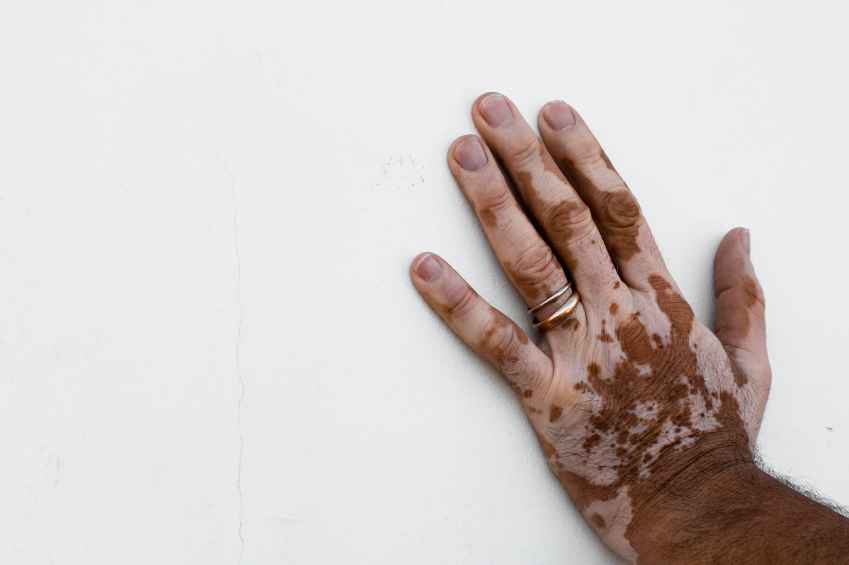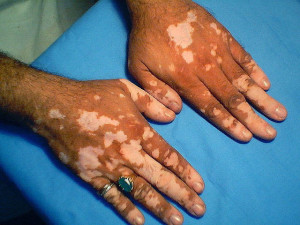New Treatment Gives Hope to Vitiligo Patients

You have probably know or have seen someone whose skin looks very discolored – whiter patches of skin in some areas than their normal skin tone. This a non-contagious skin condition called vitiligo that affects about 2 million people in the United States.
What is Vitiligo?
According to NewsWise.com, vitiligo occurs when the body is triggered to view melanocytes (cells that give color to the skin) as foreign or abnormal. It is considered an autoimmune disease because vitiligo makes your body’s immune system attack those melanocyte cells. Though there is no cure, traditional treatments include medication, creams, phototherapy (shining an ultraviolet light on the body), and even an excimer laser on small areas. However, a UT Southwest Medical Center dermatologist, Dr. Amit Pandya, Professor of Dermatology, has improved a technique that transplants pigment cells to the affected areas due to the discoloration from vitiligo.
New Technology
The newly discovered technique, called non-cultured epidermal suspension (NCES) grafting, use s cells that are harvested from blisters on the skin which are then transported to areas that are missing pigment cells to restore its natural skin color. Dr. Pandya says, “The unique aspect of our procedure, which no one else in the world is doing, is the formation of blisters as the source of donor cells combined with laser surgery to prepare the grafted areas. The older method of cutting the skin leaves a scar.” Dr. Pandya begins the transplant procedure with a heat lamp to create a small blister on the individual’s thigh, where thousands of cells are then removed from the blister with a syringe and applied to the affected areas. Worried about pain? Dr. Pandya says it does not hurt – “It feels like something is sucking on your skin.” Blisters need only be 0.7 centimeters wide to cover an area 10 times as large and can come from the abdomen, thighs or buttocks. The areas that have been tested and respond well to the treatment include cheeks, forehead, neck, back, chest, abdomen, arms and legs. The areas that have a lower response rate are the nose, around the mouth, the lips, elbows, wrist, fingers, knees, ankles and toes. How many procedures required depends on the size of the affected areas.
s cells that are harvested from blisters on the skin which are then transported to areas that are missing pigment cells to restore its natural skin color. Dr. Pandya says, “The unique aspect of our procedure, which no one else in the world is doing, is the formation of blisters as the source of donor cells combined with laser surgery to prepare the grafted areas. The older method of cutting the skin leaves a scar.” Dr. Pandya begins the transplant procedure with a heat lamp to create a small blister on the individual’s thigh, where thousands of cells are then removed from the blister with a syringe and applied to the affected areas. Worried about pain? Dr. Pandya says it does not hurt – “It feels like something is sucking on your skin.” Blisters need only be 0.7 centimeters wide to cover an area 10 times as large and can come from the abdomen, thighs or buttocks. The areas that have been tested and respond well to the treatment include cheeks, forehead, neck, back, chest, abdomen, arms and legs. The areas that have a lower response rate are the nose, around the mouth, the lips, elbows, wrist, fingers, knees, ankles and toes. How many procedures required depends on the size of the affected areas.
The best candidates for the NCES procedure, Dr. Pandya explains, have stable vitiligo (not more than 10 percent worsening has been seen in the last year in the patient) and have improved with previous treatments but have reached a standstill. Though this procedure has resulted in at least a 50 percent improvement, success is not guaranteed and sometimes no pigmentation can be seen afterwards. “The color of the new pigmentation may be lighter, darker, or blotchier than the normal surrounding skin.” But Dr. Pandya is not giving up. In addition to his research and studies, he is compiling one of the five vitiligo registries in the world that collects data on patients and the disease, where he hopes to enroll hundreds of patients to better understand the diseases causes, how it evolves, and the best ways to treat it says NewsWise.com.
Source: http://www.newswise.com